
 |
Home | Gasherbrum IV Main | Contact |
Updated: October 2011. Click on an image to see the FULL size with a caption.
The following reference information is included:
My rating scale:
 Excellent ;
Excellent ;
 Very Good ;
Very Good ;
 Good ;
Good ;
 Fair ;
Fair ;
 Poor.
Poor.
Please see K2 Trekking Guidebooks.

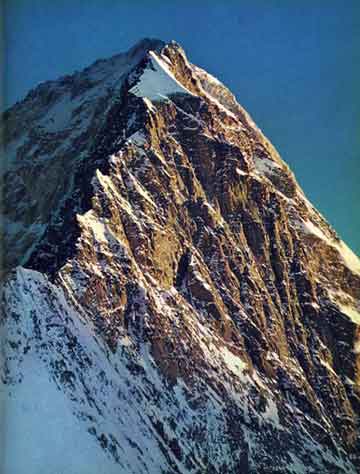
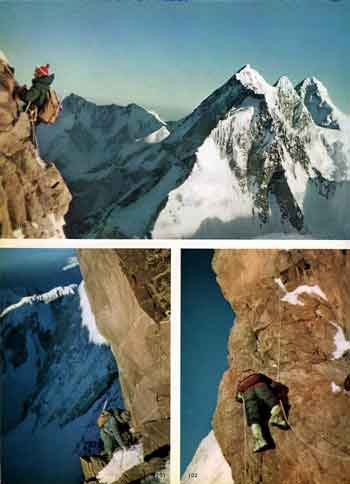



by Fosco Maraini. First published in Italian in 1959 and English in 1961. One of Michael Chessler's Top 100 Mountaineering Books. This book tells the story of the first ascent of Gasherbrum IV on an Italian expedition led by Riccardo Cassin, with Walter Bonatti and Carlo Mauri reaching the summit on August 6, 1958 via the very difficult and dangerous northeast ridge. There are 40 pages of colour photos, 40 pages of b/w photos, 5 maps, 12 routes, and 9 sketches. The cover is a porter train between Skardu and Shigar on the way to Gasherbrum IV base camp.
In addition to following the team's travel to Skardu and on to base camp suffering the usual porter problems, Maraini writes a detailed overview of the history of the Indus River, the Balti people, K2 exploration, and Gasherbrum 1-6 history. They climbed the steep icefall, gaining the col between Gasherbrum III and IV and stared at the northeast ridge. "The North-East Ridge, on closer acquaintance, proved to be jagged with rocks, rose-red in the light of a setting sun, with fantastic cornices of snow and blue ice-cliffs."
Walter Bonatti and Carlo Mauri pushed out the route and tried to conquer the northeast ridge. "One highly difficult and dangerous pitch followed another, exhausting both the physical and nervous energies of the two leading men. ... endless series of knife-edge and rock-face, cliff and overhang" They realized they needed another camp on the ridge, but the rest of the team couldn’t keep the camps stocked quickly enough so they abandoned their summit bid and descended until the supply issues could be solved.
The team set up Camp 6, and Bonatti and Mauri retraced their steps and continued to tackle the northeast ridge. The summit day commentary is mainly by Walter Bonatti. "We were on the fore-summit at ten-thirty ... Nearer and nearer came the Summit, which outlines itself in the form of a wall rising steeply to five distinct points. ... A desperate struggle between the mountain and ourselves, but we were all winners, and at 12.30 exactly the little pennants of Italy, Pakistan and the C.A.I. fluttered on the Summit itself. Fluttered – no, blew out in the howling gale. 'In spirit, the whole Expedition was with us at that solemn moment of fulfillment. We embraced each other, deeply moved.'" They descended in a blizzard, with Giuseppi de Francesch almost falling to his death at 7200m.
Although Maraini's writing is very good, almost poetic at times, this book could a lot tighter as he rambles on way too long on other topics like the Indus River and the Balti people - the team doesn't actually reach base camp until page 177. The photos are excellent.
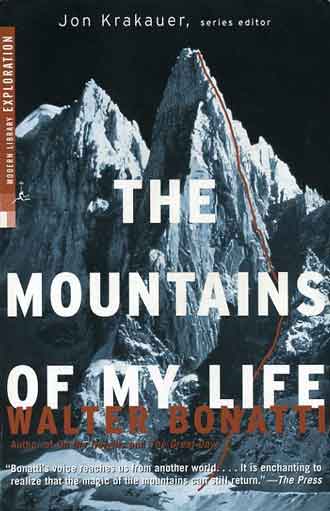
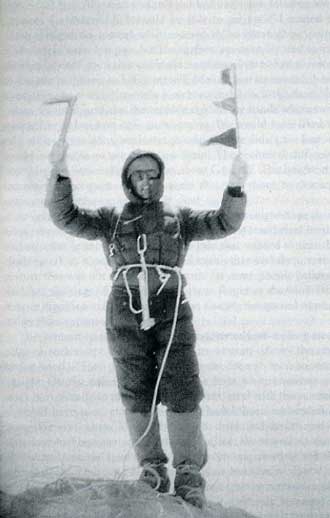

by Walter Bonatti, translated by Robert Marshall. This book collects the classic writings of world-famous mountaineer Walter Bonatti (many from On The Heights and The Great Days). The cover is Bonatti's solo route on the south-west pillar of the Petit Dru from August 17-22, 1955. The book has 26 pages of b/w photos, 3 b/w photos in-line with text, and 8 route maps.
The book starts with his climbs on Grande Jorasses, Grand Capucin and Lavaredo in winter. He was then invited on the 1954 Italian K2 expedition, where Lino Lacedelli and Achille Compagnoni became the first to summit K2. Controversy struck when the expedition leaders accused him of turning back before delivering needed oxygen to them below the summit. After staying quiet for 50 years, Lacadelli finally published his view of what happened, corroborating Bonatti's story.
Bonatti continued on to execute many great climbs, including a solo climb of a new route on the south-west pillar of the Aiguille du Dru, Cerro Torre, the first ascent of Gasherbrum IV, the North Face of the Grande Jorasses in winter, an unprecedented solo ascent of the north face of the Matterhorn in winter, and the tragic story of the death of four mountaineers from exhaustion attempting to be the first to climb the Central Pillar of Freney in June 1961.
The chapter on Gasherbrum IV is 13 pages and has 2 pages of b/w photos. Bonatti and Carlo Mauri led the climb, but had to abandon their first summit attempt because there weren't enough provisions carried up to their camps. They descended to Base Camp and ensured that "the work of resupply was coordinated, and one by one we occupied the higher camps."
"Foot by foot we neared the summit, and as the perspective changed it showed the profile of five steep rocky points, smooth and vertical, at least 160 feet high, which followed one another onto form the summit ridge. ... Under my feet was the whole glittering west face, an abyss of more than 8,000 feet. Above us was still this last unknown 160 feet. ... At exactly 12:30 P.M., we emerged on the highest peak of Gasherbrum IV, at 26,180 feet. We could scarcely stand erect on the narrow crest in the savage gusts of a gale that wanted to tear the clothing off our backs. We embraced each other and then, with a gesture that was not at all mere rhetoric we lifted the flags of Pakistan and Italy to flutter in the wind."
This is one of my top 10 favourite mountaineering books of all time. The photos are good. Bonatti packs his pages with a total punch, introspective, exciting, and dangerous. You can just about feel the bitter cold.
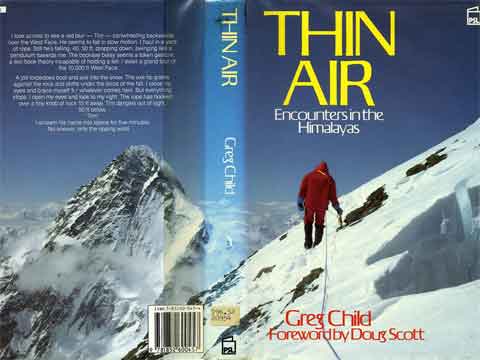
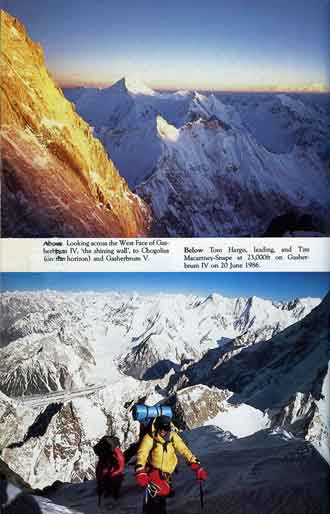
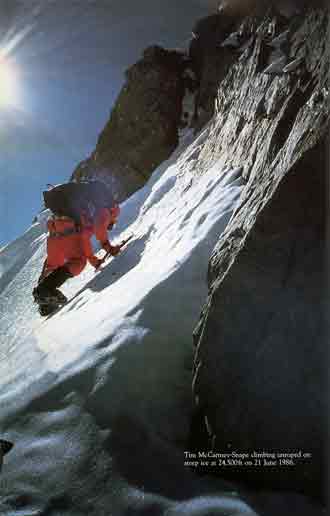
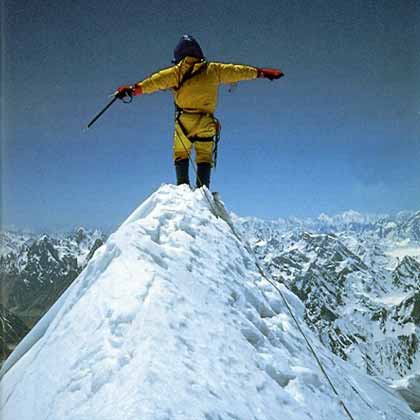

by Greg Child. First published 1988. Child writes about his expeditions to Shivling (1981), Lobsang Spire and Broad Peak (1983), and Gasherbrum IV (1986). Greg Child, Doug Scott, Georges Bettembourg, and Rick White made the first ascent of Shivling (6543m) East Pillar on June 15, 1981. Greg Child, Doug Scott, and Pete Thexton completed the first ascent of Lobsang Spire (5707m) via the South Pillar on June 13, 1983, with Child using a drill for the last 30m. Greg Child and Pete Thexton were climbing near the summit of Broad Peak when Greg developed symptoms of acute mountain sickness, so they turned back. On the way down Greg got better and Pete got worse, dying of pulmonary oedema in his sleep. Greg Child, Tim Macartney-Snape, and Tom Hargis made the first ascent of the spectacular Northwest Ridge of Gasherbrum IV on June 22, 1986.
There are 21 pages of colour photos: 7 of Shivling, 4 Lobsang, 4 Broad Peak, and 6 of Gasherbrum IV. There are 11 pages of b/w photos showing the climbing routes on Shivling, K2, Broad Peak, Gasherbrum I and IV, Chogolisa, Mustagh Tower, Masherbrum, Lobsang Spire, Trango and Nameless Towers, and Paiju Peak. The cover is Pete Thexton on Broad Peak with K2 beyond.
The story of Gasherbrum IV starts with getting permission from Pakistan and trekking to Base Camp with the usual porter problems. Child provides a good description of the Pakistan India conflict high in the mountains. The Gasherbrum IV Northwest ridge is "A 1,000 ft icefield capped by a steep 1,000 ft marble and limestone headwall. ... It would be a technical and serious climb right to the top." ... Yes, we all wanted the summit, but the physical and mental pain we had endured and would yet endure was so great that we had to force ourselves onto the mountain." After bivouacking in a snow cave at 7000m, they alternated leading pitches over difficult rock and bivouacked at 7350m.
They couldn't make it the summit the next day, so they dug another ice cave just below the North Summit at 7880m. "As we settle into the cave I feel like a stranded astronaut bedding down for the night on a hostile planet. But no, it’s our own wild and beautiful earth." On June 22, 1986 Greg Child, Tim Macartney-Snape, and Tom Hargis climbed to the North Summit and traversed 450m horizontally to the true Gasherbrum IV Summit, completing the first ascent of the Gasherbrum IV Northwest Ridge. "We functioned as a single being. Now on the summit, that being, drunk with euphoria, felt suddenly as if it had been merged with sky and mountain as well to become a single, elemental entity."
I really like Greg Child's writing style - interesting and witty. He is a keen observer and uses conversation effectively to bring immediacy to the stories. The photos are excellent. The b/w photos of the climbing routes are a very good reference.
My favourite books that partially feature Gasherbrum IV are:
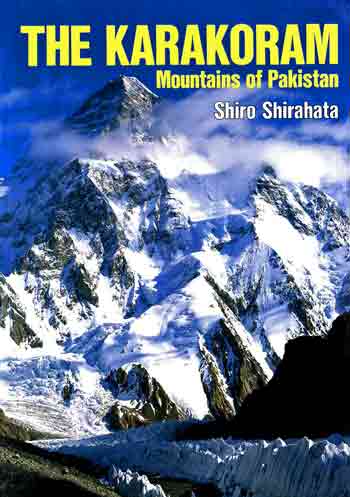
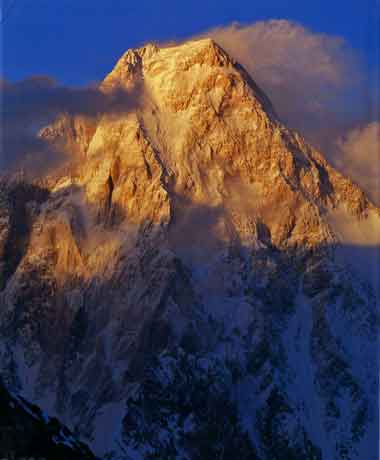

by Shiro Shirahata. Published 1990. One of Michael Chessler's Best Mountain Photo Books. He may just be the best mountaineering photographer ever. This coffee-table sized book provides stunning large photographs printed on glossy quality paper.
This book contains K2 (cover), Broad Peak, Gasherbrum I, Gasherbrum II, Gasherbrum IV, Chogolisa, Nanga Parbat, and Tirich Mir. The photo of Gasherbrum IV on the back cover is stunning.
The photos are excellent. Shirahata just may be the best mountaineering photographer ever.
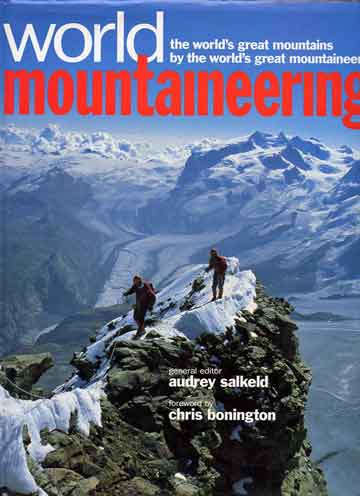
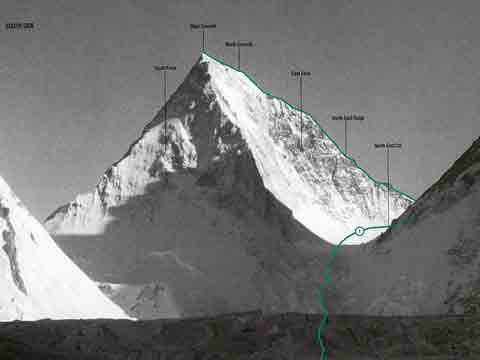

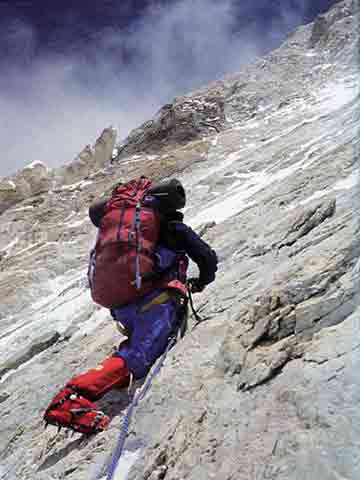

by Audrey Salkeld. Published 1998. The book briefly details 52 of the world's finest climbs from Europe (including Mont Blanc, the Matterhorn and the Eiger), Arctic and North America, South America, Antarctica, Indonesia and Oceania, High Asia and Korea and Japan (including K2, Gasherbrum IV, Nanga Parbat, Kangchenjunga, Mount Everest), and Africa. Each climb is documented with photos, excellent aerial-type maps, and a basic climbing history.
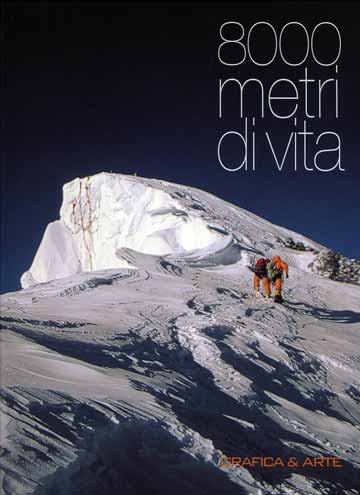
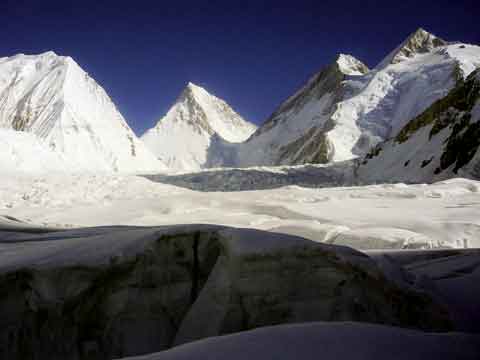
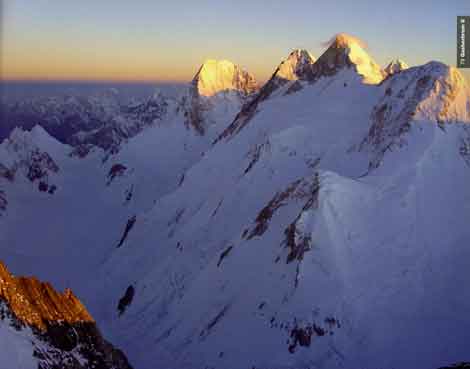

by Simone Moro. Published 2008. In Italian and English. This coffee-table size book features excellent photos from all 14 8000m peaks. Each 8000m peak has a brief history, a photo of each face showing the climbing routes, and lots of excellent photos.
There are several photos of Gasherbrum IV.
The photos and route diagrams are excellent.

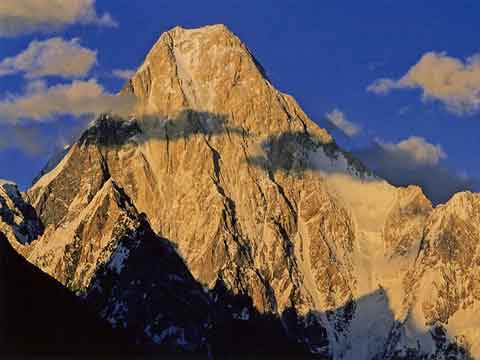
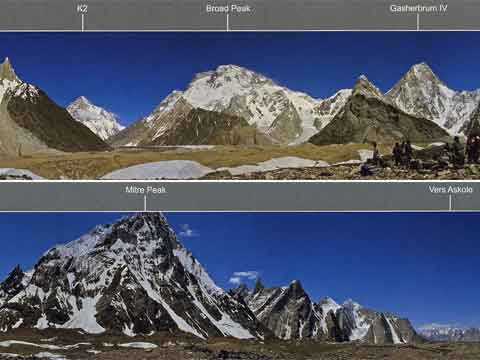

by Laurent Doldi. Published 2006. In French and English. A large soft-cover photo book detailing 10 Himalayan treks: K2 Base Camp (12 pages. 23 photos), Ladakh to Zanskar (16 pages, 38 photos), Jeep tour in Kinnaur Spiti and Ladakh (12 pages, 32 photos), the Sources of the Ganges in India (14 pages, 30 photos), Dolpo (18 pages, 36 photos), Around Annapurna (22 pages, 45 photos), Helambu and the sacred lakes of Gosainkund (16 pages, 29 photos), Rolwaling Valley in winter (18 pages, 37 photos), Everest Base Camp and Gokyo Lakes (20 pages, 41 photos), and Kangchenjunga Base Camps in Nepal (21 pages, 44 photos). Each chapter starts with a very brief overview including a map and altitude profile. The front cover is K2. There are 360 colour photos.
This is very good companion book to a trekking guide, enabling you to visualize what you will experience on a trek. The photos are very good.



by Andy Fanshawe, Stephen Venables. Published 1996. This book briefly details 40 of the world's finest climbs on mountains in Pakistan (including Broad Peak, K2 and Nanga Parbat), India, Nepal and Tibet (including Annapurna, Shishapangma, Cho Oyu, Everest, Makalu and Kangchenjunga). Each climb is illustrated with many great photos, climbing routes, and summary statistics and information. Each area has an excellent overview map.
There are 5 pages on Gasherbrum IV Northwest Ridge.
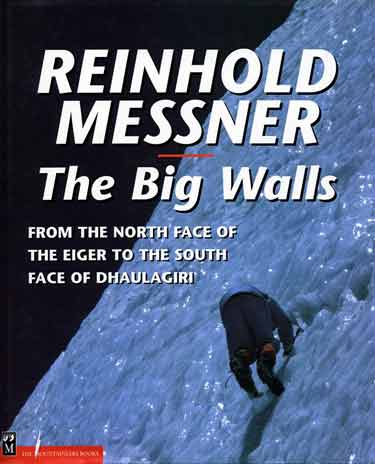
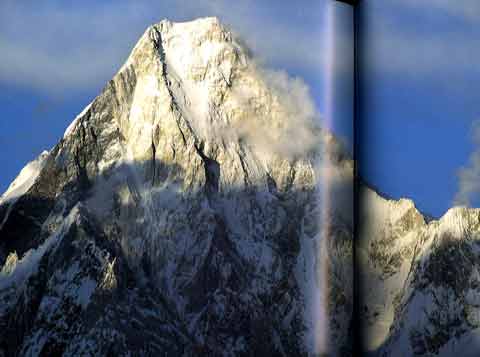

by Reinhold Messner. Revised in 2001. Messner briefly details the big mountain walls in the world in the Himalayas, the Karakorum, the Alps, South America, Alaska and the Caucasus.
It includes two pages on climbing Gasherbrum IV West Face.
I like this as a reference book. The photos are very good.
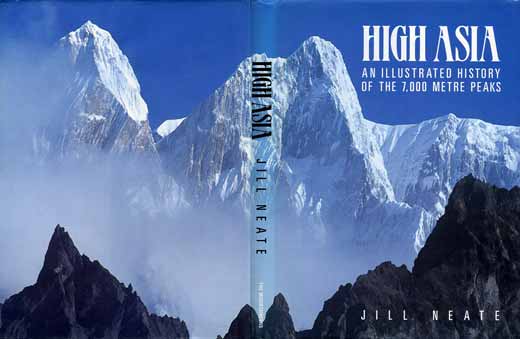
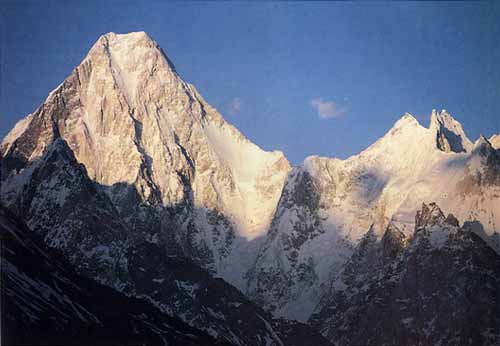

by Jill Neate. Published 1990. Documents the climbing history, including first ascents, of all the 7000m peaks in the world, their various faces and subsidiary peaks, including good photos and maps.
There are two pages to Gasherbrum IV.
For news on Gasherbrum IV expeditions, I check the following regularly:
There are a few informational Gasherbrum IV websites, with my favourites being:
Gasherbrum II Expeditions:
I thoroughly enjoy reading other people's travelogues and looking through their photos. Here are my favourites on Mustang:
In addition to the following DVDs and Videos please see youtube.com Gasherbrum IV videos.
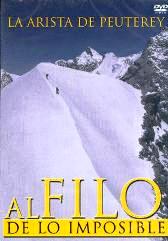
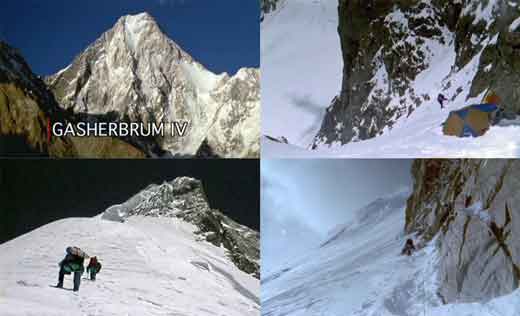
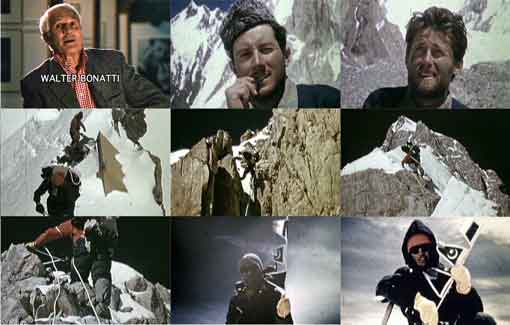

by Sebastian Alvaro. Al Filo De Lo Imposible, Spanish TV. 56 minutes. Filmed in 1997. Released in 2001. This film follows Spanish mountaineers Jose Carlos Tamayo, Paco Chavarri, Jon Lazcano, and Kike de Pablo as they attempt Gasherbrum IV in June 1997.
The film opens with scenes of K2, Broad Peak and Gasherbrum IV. Walter Bonatti talks about his first ascent of Gasherbrum IV in 1958 with Carlo Mauri, with some of the film footage from that climb. We follow the climbers are their bus passes the barren countryside and villages of Pakistan, and then follow the porters and climbers as they trek past the Trango Tower to Concordia, with its sparkling views. The climbers climb the enormous icefall to Camp I and then to the beginning of the North East Ridge, and then return to Base Camp. They climb back to Camp 1, and then up the ridge to set up Camps 2 and 3, with broad beautiful views. They reached 7300m before retreating.
This DVD has one other film, La Arista De Peuterey (51 minutes), that follows Spanish climbers Esther Sabadell and Elena Castro as they climb the entire 8km Peuterey Ridge from Courmayeur to the summit of Mont Blanc, the longest ridge in Europe, in 2002.
The filming is excellent showing that Gasherbrum IV is one of the most beautiful mountains in the world. The close up, broad view, and extreme telephoto gives the depth and scale and steepness of the climb. I enjoyed seeing the old film footage and Walter Bonatti's interview. I wish I could understand the Spanish narration.

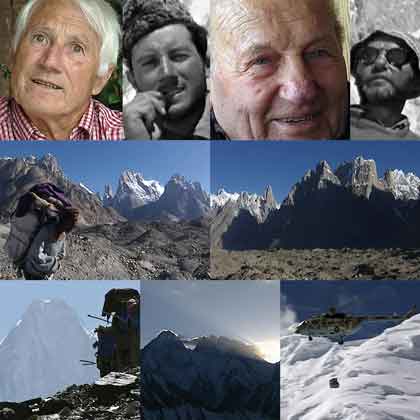
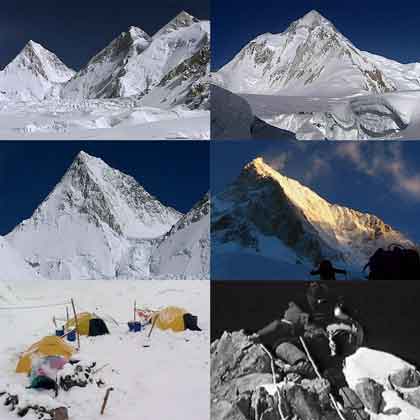

by Mario Casella and Fulvio Mariani. In Italian. 69 minutes. Filmed in 2002. Extras include a 157-page book without photos by Mario Casella about the expedition. This film follows a 2002 Swiss / Italian expedition as they attempt to climb Gasherbrum IV by the first ascent route.
The expedition team arrives in Pakistan just as military tensions rise between Pakistan and India. They quickly reach Skardu where we see the life of the common people like washing clothes in the river, the shops and the markets. The team drives in a jeep to Askole contrasted with the 1958 expedition who had to cross the Indus on a raft and trek. They hire porters in Askole and trek to Paiju, where the porters bake bread and prepare meat, and sing and dance just like they did in 1958. The weather is perfect as they trek along the Baltoro Glacier with views of Trango Towers, Uli Biaho, Cathedral Peaks, and Gasherbrum IV. They pass military camps at Urdukas and on the Baltoro Glacier, scattered with green cans and garbage.
They set up base camp (5100m) and climb through the glacier to set up Camp 1, with excellent views of Gasherbrum I, II, II and IV. Bad weather forces them back to base camp where they see a military helicopter dropping off supplies at a Pakistani Army camp on the Conway Saddle (6110m). They climb back up and set up camp 2 (6100m) and move towards the icefall below the col between Gasherbrum III and IV. After another spell of bad weather, they climb through the icefall to set up camp 3. They call off the expedition with more bad weather and increasing avalanche danger. We see a brief snippet of the 1958 expedition as Walter Bonatti reaches the summit ridge.
The filming is excellent with a good balance between the lives of the porters, the mountain scenery, climbing, and the day-to-day lives at the camps. The views from the Baltoro Glacier and of the Gasherbrums from camp 1 is excellent. I really liked the time-lapse film of sunrise from Urdukas of Uli Biaho Tower to the Cathedral Peaks. It's a pity the team didn't get to climb the Gasherbrum IV ridge - that would have been fascinating.